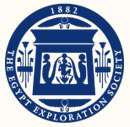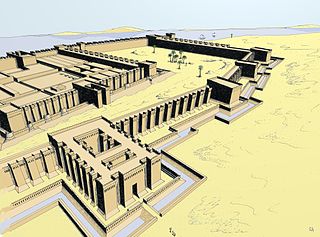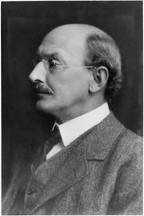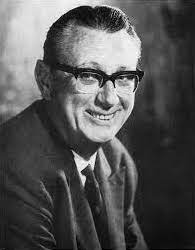
Egyptology is the scientific study of ancient Egypt. The topics studied include ancient Egyptian history, language, literature, religion, architecture and art from the 5th millennium BC until the end of its native religious practices in the 4th century AD. A practitioner of the discipline is an "Egyptologist".

Sir William Matthew Flinders Petrie, commonly known as simply Sir Flinders Petrie, was a British Egyptologist and a pioneer of systematic methodology in archaeology and the preservation of artefacts. He held the first chair of Egyptology in the United Kingdom, and excavated many of the most important archaeological sites in Egypt in conjunction with his wife, Hilda Urlin. Some consider his most famous discovery to be that of the Merneptah Stele, an opinion with which Petrie himself concurred. Undoubtedly at least as important is his 1905 discovery and correct identification of the character of the Proto-Sinaitic script, the ancestor of almost all alphabetic scripts.

The Egypt Exploration Society (EES) is a British non-profit organization. The society was founded in 1882 by Amelia Edwards and Reginald Stuart Poole in order to examine and excavate in the areas of Egypt and Sudan. The intent was to study and analyze the results of the excavations and publish the information for the scholarly world.

George Andrew Reisner Jr. was an American archaeologist of Ancient Egypt, Nubia and Palestine.

Buhen was an ancient Egyptian settlement situated on the West bank of the Nile below the Second Cataract in what is now Northern State, Sudan. Buhen, as a settlement was established during the Old Kingdom, but the fortress which Buhen is famous for was not established until the Middle Kingdom. During the Old Kingdom, Buhen was primarily used to smelt copper, until the Middle Kingdom, when the site was used by Egyptians to maintain the new southern border of Egypt.

Francis Llewellyn Griffith was an eminent British Egyptologist of the late 19th and early 20th centuries.

John Garstang was a British archaeologist of the Ancient Near East, especially Egypt, Sudan, Anatolia and the southern Levant. He was the younger brother of Professor Walter Garstang, FRS, a marine biologist and zoologist. Garstang is considered a pioneer in the development of scientific practices in archaeology as he kept detailed records of his excavations with extensive photographic records, which was a comparatively rare practice in early 20th-century archaeology.
Barry John Kemp, is an English archaeologist and Egyptologist. He is Professor Emeritus of Egyptology at the University of Cambridge and directing excavations at Amarna in Egypt. His widely renowned book Ancient Egypt: Anatomy of a Civilisation is a core text of Egyptology and many Ancient History courses.

David Bourke O'Connor was an Australian-American Egyptologist who primarily worked in the fields of Ancient Egypt and Nubia.
Henry Reginald Holland Hall MBE, FBA, FSA was an English Egyptologist and historian. In life, he was normally referred to as Harry Reginald Hall.

Walter Bryan Emery, CBE, was a British Egyptologist. His career was devoted to the excavation of archaeological sites along the Nile Valley. During the Second World War, he served with distinction as an officer in the British Army and, in the immediate aftermath, in the Diplomatic Service, both still in Egypt.
The A-Group culture was an ancient culture that flourished between the First and Second Cataracts of the Nile in Lower Nubia. It lasted from c. 3800 BC to c. 3100 BC.
Geoffrey Almeric Thorndike Martin was a British egyptologist, Edwards Professor of Egyptian Archaeology and Philology Emeritus, University College, London, Joint Field Director of the Amarna Royal Tombs Project and fellow commoner of Christ's College, Cambridge.

Selim Hassan was an Egyptian Egyptologist.
Aylward Manley Blackman, FBA was a British Egyptologist, who excavated various sites in Egypt and Nubia, notably Buhen and Meir. Having taught at Worcester College, Oxford, he was Brunner Professor of Egyptology at the University of Liverpool from 1934 to 1948. He was additionally a special lecturer at the University of Manchester, and was involved in or led a number of excavations with the Egypt Exploration Society.
Tuthmose was the Viceroy of Kush during the reign of Akhenaten. Tuthmose was given the titles King's Son of Kush, Overseer of the Gold Lands of Amun, Overseer of masons, Overseer of the borderlands of His Majesty, and Fan-bearer on the King's right.

Kate Bradbury Griffith was a British Egyptologist who assisted in the early development of the Egypt Exploration Society and the Department of Egyptology at University College London (UCL). Bradbury was born in Ashton-under-Lyne, near Manchester, UK, to Elizabeth Ann Tomlins and businessman Charles Timothy Bradbury.
Jack MartinPlumley, was a British Anglican priest, Egyptologist and academic. Having served as a priest in the Church of England, he was Sir Herbert Thompson Professor of Egyptology at the University of Cambridge from 1957 to 1977.

Shalfak is an ancient Egyptian fortress once built up on the western shore of the Second Cataract of the Nile River and now an island in the Lake Nubia in the north of Sudan. Set up in the Middle Kingdom under Senusret III, it is one of a chain of 17 forts which the pharaohs of the 12th Dynasty established to secure their southern frontier during a time where the Egyptian influence was sought out to be expanded. That is why Shalfak, along with the forts of Buhen, Mirgissa, Uronarti, Askut, Dabenarti, Semna, and Kumma, was established within signalling distance of each other.
Fayza Mohamed Hussein Haikal is a professor emerita of Egyptology at the American University in Cairo and the first Egyptian woman to earn a PhD in Egyptology.












